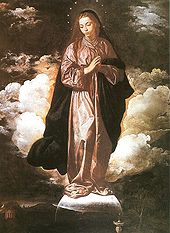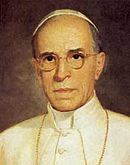- Doctor Mellifluus
-
Doctor Mellifluus is an encyclical of Pope Pius XII on the doctor of the Church Bernard of Clairvaux, given at Rome, St. Peter's, on the 24th of May, on the feast of Pentecost, 1953, in the 15th year of his pontificate.

A series of articles on
Roman Catholic
Mariology

General articles
Mariology • Veneration of the Blessed Virgin • History of Mariology • Mariology of the saints • Mariology of the popes • Encyclicals • Marian SocietiesDevotions
Rosary • Scapular • Immaculate Heart • Seven Joys • Seven Sorrows • First Saturdays • Acts of Reparation • Hearts of Jesus & Mary • Consecration to MaryDogmas and Doctrines
Mother of God • Perpetual virginity • Immaculate Conception • Assumption • Mother of the Church • Mediatrix • Co-Redemptrix
Expressions of devotion
Art • Hymns • Music • ArchitectureKey Marian apparitions
(approved or worthy of belief)
Guadalupe • Miraculous Medal •
La Salette • Lourdes • Pontmain • Laus • Banneux • Beauraing • Fátima • AkitaContents
Theology
“The "Doctor Mellifluus, the last of the Fathers, but certainly not inferior to the earlier ones, was remarkable for such qualities of nature and of mind”, begins Pius XII the encyclical letter. The Pope highlights that Bernard had a rather low opinion of speculative theology. “His teaching was drawn, almost exclusively, from the pages of Sacred Scripture and from the Fathers, which he had at hand day and night in his profound meditations: and not from the subtle reasoning of dialecticians and philosophers, which, on more than one occasion, he clearly held in low esteem. It should be remarked that he does not reject that human philosophy which is genuine philosophy, namely, that which leads to God, to right living, and to Christian wisdom. Rather does he repudiate that philosophy which, by recourse to empty wordiness and clever quibbling, is overweening enough to climb to divine heights and to delve into all the secrets of God, with the result that, as often happened in those days, it did harm to the integrity of faith and, sad to say, fell into heresy.[1]
He described the great character, abilities, sanctity and knowledge of Bernard. The encyclical uses several quotes of the saint, in a largely historical review. Only in few places, Pope Pius draws parallels to the present times, thus when he describes the ardent love of God and the mystical qualities and doctrines of the saint, which are “neglected or even forgotten today”. The encyclical highlights the role of the papacy in the writings of Bernard and his mariology.
Bernard differentiates different kinds of knowledge, the highest being theological. Some who want knowledge for the sole purpose of knowing, and this to him is unseemly curiosity. Some seek knowledge in order to be known themselves; this is unseemly vanity. And there are also those who seek knowledge in order to sell their knowledge, for example, for money or for honors; this is unseemly quest for gain.
- But there are also those who seek knowledge in order to edify, and this is charity. And there are those who seek knowledge in order to be edified, and this is prudence.[2]
Mariology
Bernard prayed for the intercession of Mary in his confused time. The faithful today are requested to equally turn to Mary to pray for peace and freedom for the Church and the nations of this world. “To this warm love of Jesus Christ was joined a most sweet and tender devotion towards His glorious Mother, whose motherly love he repaid with the affection of a child, and whom he jealously honoured. So great was his confidence in her most powerful intercession, that he did not hesitate to write: "It is the will of God that we should have nothing which has not passed through the hands of Mary." Likewise: "Such is the will of God, Who would have us obtain everything through the hands of Mary." [3] Pope Pius concludes his Encyclical Letter in the words of Bernard " to invite all to be more and more devout to the loving Mother of God, and each in his respective state in life, to strive to imitate her exalted virtues”.
Doctor Mellifluus quotes three central elements of Bernard’s mariology: How he explained the virginity of Mary, the “Star of the Sea”, how the faithful should pray on the Virgin Mary, and how Bernard relied on the Virgin Mary as Mediatrix.
- Mary […] is interpreted to mean 'Star of the Sea'. This admirably befits the Virgin Mother. There is indeed a wonderful appropriateness in this comparison of her with a star, because as a star sends out its rays without harm to itself, so did the Virgin bring forth her Child without injury to her integrity. And as the ray does not diminish the rightness of the star, so neither did the Child born of her tarnish the beauty of Mary's virginity.[4]
- When the storms to temptation burst upon you, when you see yourself driven upon the rocks of tribulation, look at the star, call upon Mary. When swallowed by pride or ambition, or hatred, or jealousy, look at the star, call upon Mary. Should anger, or avarice, or fleshly desire violently assail the frail vessel of your soul, look at the star, call upon Mary. If troubled on account of the heinousness of your sins, distressed at the filthy state of your conscience, and terrified at the thought of the awful judgment to come, you are beginning to sink into the bottomless gulf of sadness and to be swallowed in the abyss of despair, then think of Mary. In dangers, in doubts, in difficulties, think of Mary, call upon Mary. Let not her name leave thy lips, never suffer it to leave your heart.[5]
Theologically, Bernard, a Doctor of the Church, is a fervent supporter of the Mediatrix interpretation of Mary. God and World meet in her.[6] Divine life flows through her to the whole creation. She is one with Jesus, who wants to save all and who passes all graces through her.[7] She is the mediatrix to God, the ladder on which sinners may climb up to him, the royal road to him, because she is full of grace.[8]
Pope Pius XII (1939–1958) Biography Early life · Nunciature · US visit · Election · Late years · Illness and death · Testament · Cause for Canonization
World War II The Holocaust (statements on) (conversion of Jews during) · Roman razzia · Occupied dioceses · Ustaše involvement · Jewish orphans · Pontifical Relief Commission · 1942 Christmas address · Alleged kidnapping plot · Yad Vashem · Bombing of RomeForeign relations Nazi Germany (Reichskonkordat) · Post-World War II · "Ratlines" · Persecutions · China · Eastern Europe · Poland · RussiaTheology Social teachings · Mariology · Judaism · Liturgy · Eastern Canon Law · Canonizations · Beatifications · Fátima and BalasarWritings Appointments Advisers Bibliography Pope Portal  Catholicism Portal
Catholicism PortalReferences
- Encyclical Doctor Mellifluus on the Vatican website
- Encyclical Mystici Corporis Christi on the Vatican website
- Acta Apostolicae Sedis. (AAS), Vatican City 1939-1958. Official documents of the Pontificate of Pope Pius XII
Notes
- ^ Doctor Mellifluus 3
- ^ In Cantica, Serm. XXXVI, 3; Migne, P. L., CLXXXIII, 968c,-d.
- ^ Doctor Mellifluus 30
- ^ Bernard of Clairvaux quoted in Doctor Mellifluus 31
- ^ Hom. II super "Missus est", 17; Migne, P. L., CLXXXIII, 70-b, c, d, 71-a. Quoted in Doctor Mellifluus 31
- ^ PL 138, 328
- ^ PL 138, 441
- ^ PL 183, 43
Categories:- Pope Pius XII mariology
- Pope Pius XII encyclicals
Wikimedia Foundation. 2010.
